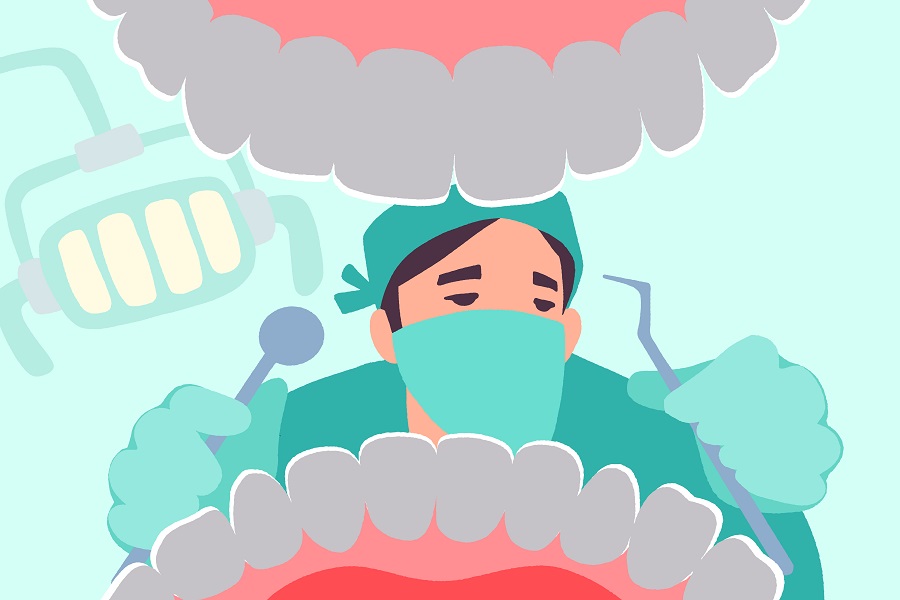
In the year 2023, the American Cancer Society predicts that over 50,000 Americans will be diagnosed with a form of oral cancer. Despite broadly available screenings and diagnostic testing, many cases aren’t diagnosed until the cancer is in advanced stages, which notably reduces the ability to provide effective treatment and poses issues for patients and healthcare providers alike.
For Oral Cancer Awareness Month in April, Dr. Nelson Rhodus with the University of Minnesota School of Dentistry talks about what oral cancer is, risk factors for the disease and why early detection is so important.
Q: What causes oral cancer?
Rhodus: The biochemical factors behind oral cancer are still not fully understood. However, at least 80% of cases of oral cancer are associated with cellular abnormalities resulting from chronic and excessive exposure to carcinogens found in smoking tobacco, smokeless tobacco, alcohol and areca nut chewing. UV light exposure and immunodeficiency — such as HIV, or side effects of procedures such as solid organ transplantation — are associated with approximately 10% of cases. High-risk HPV infections are additionally detected in about 30% of cases, particularly those involving the base of the tongue and tonsils. More than one risk factor can contribute to a patient's diagnosis, as well.
Q: What risk factors are there for oral cancer, and what preventative measures can people take to avoid them?
Rhodus: Use of carcinogenic substances — such as those listed above — is the highest risk factor for anyone developing oral cancer. Not only does avoiding these substances reduce the general risk for getting oral cancer, but it also improves the rate of survival for those who are diagnosed. Gender, age, poor oral hygiene, poor physical health and even having fair skin can increase your likelihood of developing oral cancer, in addition to previously mentioned infections such as HPV and immunodeficiencies. Making healthy lifestyle choices is the most important way you can reduce risk factors.
Q: What type of treatments are available for oral cancer? What is the outlook for those diagnosed?
Rhodus: Treatment for oral cancer varies related to the stage of the cancer when it is detected and the severity of the disease. However, treatments commonly include surgical removal of tumors, radiation therapy and chemotherapy.
Early detection is critical in successful intervention for oral cancers. Oral cancer has a five-year survival rate of a little over 50% — however, this number isn’t lower than you might expect because it is particularly difficult to diagnose or treat compared to other cancers. It’s often simply detected too late to treat effectively. Regular oral cancer screenings are essential to tackle the disease when treatment will be the most effective.
Q: What types of screening can be done to detect oral cancer?
Rhodus: The best way to detect oral cancer at its earliest stages is frequent, thorough oral exams. The American Dental Association recommends that adults see a dentist for a routine check up once a year. The good news is that if you’re keeping up to date on your routine dental exams, you’ll also be keeping up to date on your oral cancer screenings. Screenings are included as a normal part of your routine exam.
If your dentist notices any abnormalities, the next step will be a referral to an oncologist for testing, biopsy and — if needed — surgery of any suspected lesions.
Outside of your regular screenings, it’s important to keep an eye out for common symptoms of oral cancer and schedule an appointment with your dentist if you notice something out of the ordinary. Look out for:
- Growths and lumps inside the mouth
- Sores in and around your oral cavity that won’t heal
- Discolored red or white patches in the mouth
- Loose teeth
- Persistent ear, mouth and throat pain
Q: What work are you doing to advance knowledge of and treatment for oral cancer?
Rhodus: Our research team at the University of Minnesota has three main goals that guide both our day-to-day work and our long-term research initiatives. The first is to promote early detection of oral cancers by improved, valid and reliable diagnostic technologies. Some diagnostic techniques our team is focusing on involve different light-based and magnifying sources, special stains and dyes and improvements to imaging technology. The second is centered on the use of saliva and changes in its specific biomarkers that can be used to detect oral abnormalities which may be oral cancer in its earliest stages, or even identifying benign lesions that could develop into oral cancer over time. And third, our team is dedicated to educating health professionals on proper and reliable examination techniques for oral cancer, with a particular focus on early diagnosis. Public education regarding reduction of risk factors and the necessity of frequent oral examinations is another important part of our work to reduce the risk of oral cancer and improve the outcome for those who are diagnosed.
Dr. Nelson Rhodus, DMD, MPH, FICD, FRCSEd is a Morse Distinguished Professor and the director of the Division of Oral Medicine, Diagnosis and Radiology in the Department of Diagnostic and Surgical Sciences at the University of Minnesota School of Dentistry. He is an adjunct professor of Otolaryngology in the Medical School, a Masonic Cancer Center member, a consultant to the Veteran's Hospital and Hennepin County Medical Center and a diplomate and fellow of the American Board of Oral Medicine.
-30-
About the School of Dentistry
The University of Minnesota School of Dentistry advances health through scientific discovery, innovative education and the highest-quality care for all communities. As the state's only dental school, the School of Dentistry educates the next generation of oral health professionals and is a resource to five states for dental education and consultation. Of Minnesota’s practicing dentists, 72 percent are graduates of the dental school. Through its clinics, the School of Dentistry also sees more than 116,000 patient visits each year. Learn more at dentistry.umn.edu.
About “Talking...with U of M”
“Talking...with U of M” is a resource whereby University of Minnesota faculty answer questions on current and other topics of general interest. Feel free to republish this content. If you would like to schedule an interview with the faculty member or have topics you’d like the University of Minnesota to explore for future “Talking...with U of M,” please contact University Public Relations at [email protected].




